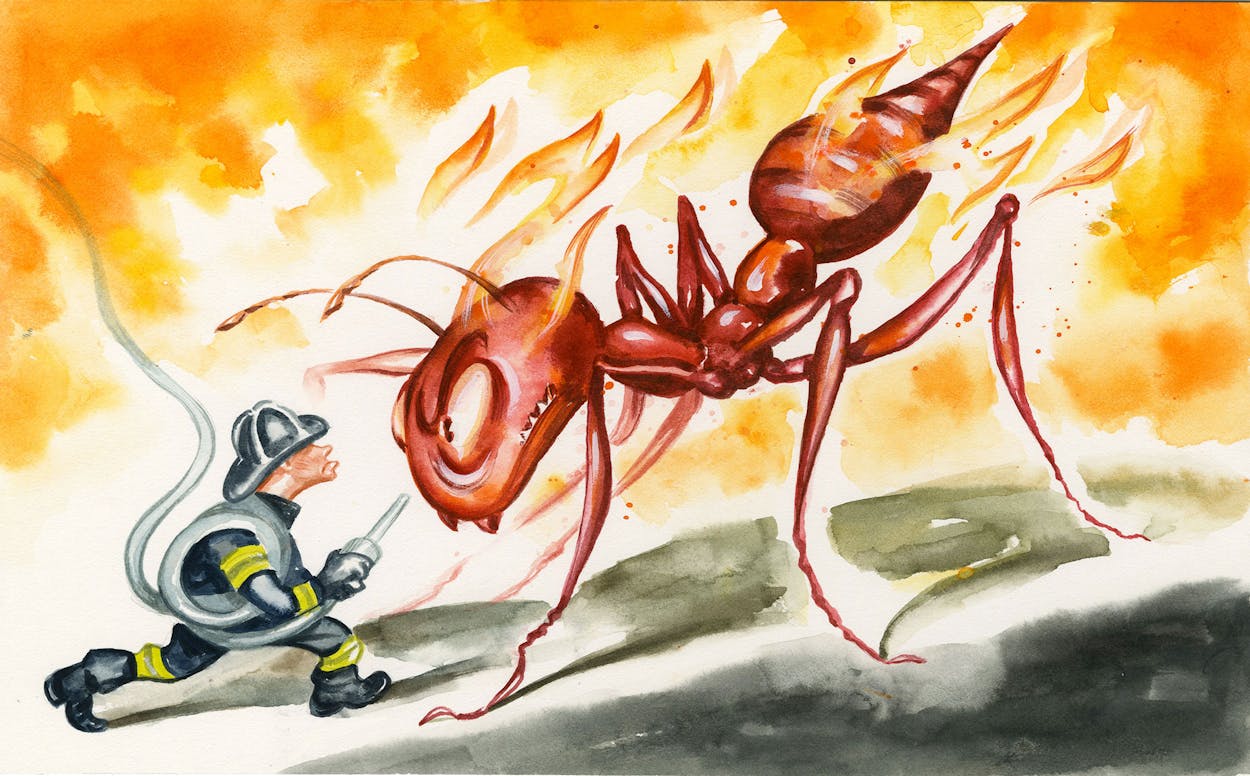Q: My four-year-old son recently had his first run-in with fire ants and came away with about ten good bites. Being a native Texan, I considered the event to be a rite of passage of sorts. His mother, a Canadian, did not see it that way. She claims, by the way, that there are no fire ants in Canada. Anyway, we got into an argument about the proper treatment of the bites. You know how they turn into those little pimple-like bumps after about day? Well, I have always popped those things just as soon as they have shown up. My wife insisted that this was a bad idea and that the bites should be left alone to heal on their own. So, for future reference, what is the appropriate way to handle a fire ant bite? Do you pop or do you not pop?
James Walters, Dallas
A: The Texanist, like most every Texan who has ever spent any amount of time outdoors, is no stranger to the terrible scald of Solenopsis invicta, a.k.a. the red imported fire ant or, more commonly, those evil little @$*!%*#@%&!s. If he had a nickel for every time he’s fallen victim to these tiny attackers, the Texanist would probably be fishing for brown trout in Tierra del Fuego instead of answering questions about fire ant bite pustules. Alas, the only thing he’s gained from such encounters is a trove of personal knowledge, a portion of which, since he’s not fishing in South America, he’d be happy to share with you now.
Among all the biting, stinging, pinching, pricking, scratching, and scraping things found on the Lone Star landscape, the fire ant, if not the deadliest of them all, is perhaps the most pervasive of our pernicious pests. They’re everywhere: parks, playgrounds, golf courses, baseball diamonds, football fields, gardens, river bottoms, creek beds, beaches, lakeshores, backyards, front yards, side yards, pastures, fields, and just about anywhere there is dirt to be found.
You may be surprised to learn that it has not always been the case that fire ants have bedeviled Texans. The red imported fire ant, as the name indicates, is not an ant species native to these parts. Hailing from South America, they first arrived, it is thought, in Mobile, Alabama, via ship in the 1930s. From there, like a horde of six-footed Mongol conquerers, they marched westward (and eastward and northward), making their way to Texas (and Florida and Tennessee) in the 1950s.
Nowadays, the pesky scourge that is the fire ant can be found wreaking its anty havoc everywhere. They get into homes and electrical utility equipment, they build large mounds that can damage mowing equipment, they kill newborn calves, and they cost the Texas economy a reported billion dollars a year. And they sting people.
The common human versus ant run-in goes something like this: An unsuspecting guy, say the Texanist, is standing around at his daughter’s pee-wee soccer game when, during a lull in the on-field action, he casually glances down toward his feet. “Hmm. That’s strange,” he thinks to himself. “The Texanist doesn’t recall having put on shimmering dark red knee-high socks this morning. Come to think of it, he doesn’t remember ever even seeing a pair of socks like these in his underwear/sock drawer before. Where would a person even get a pair of socks like these? Maybe they belong to the missus, although he’s never seen her in them before. It’s weird how they seem to sort of undulate, moving as if they were alive.” Suddenly, his eyes bug out and the familiar flailing, thrashing, expletive-filled dance that is the hallmark of such discoveries ensues. “FIRE ANTS!”
Inevitably, this cacophonous choreography is followed by a pain. The good news is that such stings are mostly survivable, though about 1 percent of the population is allergic and can suffer severe reactions. The bad news is that they hurt like a mother#$*&%. And with good reason. Diabolical little creatures that they are, fire ants deliver their punishment in a dastardly two-stage attack. First they bite their victim, locking on with their powerful mandibles in order to firmly anchor themselves for the poison-packed sting to come. And then it comes. The result of this nasty entomological one-two punch is a burning red welt that itches like the dickens and, within a day or so, forms the small, zit-sized pustule about which you have posed a question (thanks for your patience).
Since you asked, the Texanist will come right out (after six paragraphs of fat-chewing) and admit it: he always pops these little pimples of poison. But the Texanist is not a medical doctor and must dissuade advice seekers from doing as he says he does instead of doing as he says to do. Therefore, he has turned to his poker buddy and unofficial personal physician, a licensed and well-regarded medical doctor who for obvious reasons wishes to go unnamed, for advice. And that advice is: resist the urge to pop the fire ant sting or risk a secondary infection.
The Texanist is sorry if this is not what you wanted to hear. As a consolation prize, he will send you away with this bit of wisdom: Always be aware of your surroundings and always, for all kinds of good reasons, watch where you step. Piles of fire ants aren’t the only piles out there that you want to be careful of. And, by the way, your wife is right. There are no fire ants in Canada. At least not yet.
Have a question for the Texanist? He’s always available at texanist@texasmonthly.com. Write to him there and be sure to tell him where you’re from.
video: crazier than fire ants
Watch Texas Country Reporter’s interview with Tom Raspberry, the pest control expert leading the charge against crazy ants.








